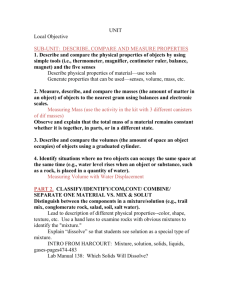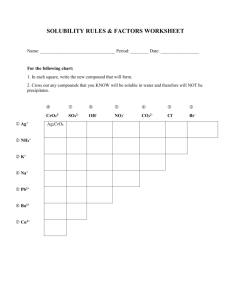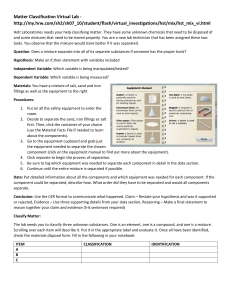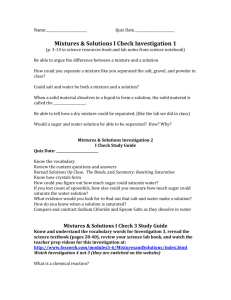SC.5.P.8.3-Mixtures
advertisement
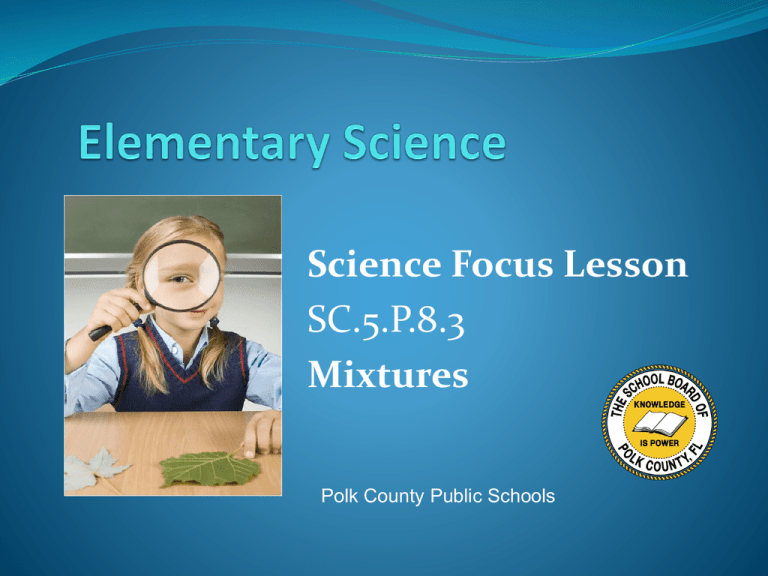
Science Focus Lesson SC.5.P.8.3 Mixtures Polk County Public Schools SC.5.P.8.3 Benchmark: Demonstrate and explain that mixtures of solids can be separated based on observable properties of their parts such as particle size, shape, color, and magnetic attraction. Essential Question: How can mixtures be separated? Vocabulary: mixture dissolve physical properties Physical Properties of Matter Matter – everything that takes up space and has mass. Let’s look at some physical properties of matter that you can observe: SIZE MAGNETIC ATTRACTION SHAPE VOLUME COLOR SINK/FLOAT Mass, density, texture, ability to transfer heat and electricity, ability to bend and transparency are more examples of physical properties of matter. A mixture is when two or more substances are physically but NOT chemically combined and can be separated again. The substances in a mixture are not permanently combined, and their properties don’t change. They can be separated(taken apart) from each other again. The change can be reversed. A new material is not formed. Sometimes it’s easy to see the parts of a mixture. If you mix sand and water and shake it up, the water looks cloudy. If you let the sand and water mixture sit for awhile, the sand will fall to the bottom. Granola Sand & Coins Water & Sand Metal & Sand Salad These mixtures can be easily separated. Minerals At other times, it is hard to see the parts that were mixed. If you mix salt with water and shake it up. The salt dissolves. It will not fall to the bottom. This kind of mixture is called a solution. Dissolve means to form a solution with another substance. The substances are spread out evenly and you cannot see the separate substances in this mixture. Salt Water-Ocean Food Coloring & Water Water & Salt Lemonade Coffee Water & Sugar These mixtures cannot be separated easily. With your shoulder partner, complete the following 3-2-1 summary: 3 – Name and discuss 3 physical properties of matter 2 – Name and discuss 2 mixtures. Choose 2 that are easily separated 1 – Name and discuss 1 mixture that is not easily separated. Include the word dissolve in your discussion How can we separate mixtures? You now know that some mixtures are easy to separate and some are not. For example, you can separate the cereal from the milk by passing it through a strainer. The cereal pieces would get “caught” in the strainer while the milk would pass through the holes. Separating the salt from salt water would be much more difficult. Forceps Other tools you may use to separate mixtures are shown here. Think about which one you might use to separate the salt from the salt water.(collaborative pairs discuss) Share your answer. Strainer Magnet Funnel & Filter Heat for evaporation Talk to your shoulder partner and decide how you would separate the substances in these mixtures. Tools Mixtures sand and water oil and water iron filings and sand trail mix Salt and water Forceps Sieve Heat or evaporation Funnel with filter magnet How can we speed up or slow down how a material dissolves in water? 1. Temperature – if you increase the temperature of the water by heating it up, the material(salt, sugar, etc.)will dissolve FASTER because molecules move faster in hot water than in cold. 2. Stirring – if you stir the mixture, the material will dissolve FASTER because the particles will connect faster with all the movement the stirring causes. 3. Surface Area – if you take two of the same size sugar cubes and put one of the cubes in water and then divide the other sugar cube into 4 pieces(increasing its surface area) and put it in a different container of water, the 2nd cube will dissolve FASTER because it had more surface area than the cube that wasn’t divided up in pieces. ROUND TABLE: Starting with the shortest person in your group, name and discuss the 3 conditions that speed up the dissolving process. If there is a 4th person in your group, they have to review all 3 conditions again for the group. Guided Practice Work with your shoulder partner to answer each question 1. Kate had two cups of water. She added a tablespoon of sugar to one cup and mixed it. She put a tablespoon of sand in the second cup and mixed it. What happened to the sugar and sand when Kate mixed them with water? A. The sand dissolved forming a solution; the sugar did not dissolve. B. The sand dissolved forming a solution; the sugar evaporated. C. The sugar dissolved forming a solution; the sand did not dissolve. D. The sugar melted; the sand did not melt. Kate observed that the sugar dissolved but the sand did not. Guided Practice 2. Juan was hungry. He put cheese, ham, tomato, and pickle on a slice of bread. He folded the bread in half and ate it. Which of the following describes what Juan made when he combined all these ingredients? A. a solution B. a change of state C. a chemical change D. a mixture Juan made a mixture when he combined the ingredients. Guided Practice 3. Joey’s teacher asked him to combine several substances to make a solution. Which picture shows what Joey made? A. B. C. D. Joey made lemonade. The sugar and flavoring dissolved in the water to make a solution. With your shoulder partner, write the definition of dissolve and make a list of common materials that will dissolve in water and those that will not. Check Your Understanding Record your answers. Check them at the end. 1. Sam made iced tea for his mom. He added sugar. The sugar was at room temperature. He stirred the iced tea until the sugar dissolved. Which property of sugar stayed the same when Sam added sugar to the iced tea? A .taste of the sugar B. grains of the sugar C. temperature of the sugar D. texture of the sugar Check Your Understanding 2. Which of the following lists of materials would ALL dissolve in water? A .salt, oil, chalk, flour B. salt, soil, sand, sugar C. salt, sugar, coffee, flour D. salt, pepper, sugar, oil Check Your Understanding 3. If your science teacher asked you to separate a mixture of sand and iron filings, which would be the best method to use? A . Use tweezers B. Use a magnet C. Use a filter D. Use evaporation Check Your Understanding 4. Which action below would be the fastest way to dissolve a sugar cube in a cup of water? A . Put the cup in the refrigerator B. Let the cup sit still for 10 minutes C. Add more water to the cup D. Break the sugar cube up into smaller pieces before putting it in the water Check Your Answers 1. A 2. C 3. B 4. D Write a summary paragraph explaining what you know about mixtures and how they can be separated. Include the following vocabulary: physical properties, mixture, dissolve.
